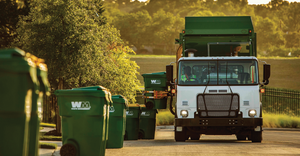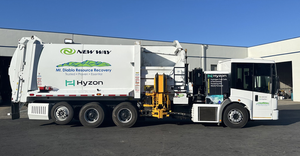How San Antonio’s Recycling Fee is Working So Far
San Antonio has begun cracking down on recycling scofflaws, who will soon start receiving fines if they don't reduce contamination levels.
Earlier this month, the City of San Antonio’s Solid Waste Management Department put in place a $25 fine for residents that don't recycle correctly.
So far, solid waste inspectors are leaving behind carts and marking them with warning tags. The city also is mailing letters to residents that include photos of what inspectors found in their carts, cart numbers and photos that include the addresses of the homes—to the correct individuals are receiving the information for the correct carts.
The second time inspectors see unacceptable items, carts will be left and residents will receive fine tags along with new letters with photos, this time letting them know they have received $25 fines. The fines will be assessed through the city’s billing agent, CPS Energy.
“Now we have to service that cart as trash, and we have to send a special truck out to get the cart. And that’s really what the fine is about. It’s us having to collect the cart as trash versus being able to receive the cart as recycling,” says Tiffany Edmonds, public relations manager for the city’s solid waste management department.
So far, says Edmonds, no fines have been levied on residents, but warning tags are being placed on blue bins with garbage inside.
The fine isn’t intended for those who may make the mistake of tossing a bit of styrofoam – not recyclable in San Antonio’s program – or other non-recyclable items in the bin, says Edmonds. Instead, it’s for those using the recycling cart as a second garbage cart.
“We have to get to those individuals who are, because they are harming a lot of the good that the majority of the residents are doing," she says. "So this is an option we’re hoping will curb that behavior.”
Among the worst of the items coming into the ReCommunity Recycling’s San Antonio plant, which sorts approximately 90,000 tons of recyclables, is the more than 200 pounds of diapers each hour, says Sean Duffy, the company’s president and COO.
This poses a serious health risk to workers at the plant, says Duffy. When the dirty baby and adult diapers come through the system, employees have to stop and remove them. This means employees have to be outfitted in personal protective equipment – from face shields, gloves and more—to protect them and the other employees from the hazardous waste.
The confusion over diapers in the recycling is a bit of a mystery to both the city and Charlotte-based ReCommunity.
“We’re not sure why people are placing them in there,” says Edmunds. “We know that the box says it’s recyclable, but that’s the cardboard box. So we’re not sure if that‘s the problem, but we know that that is something that we don’t want the employees at the plant to have to touch. That’s, of course, hazardous waste – a bio waste – just like the sharps, needles. If an employee gets stuck, they have to go through a series of shots. We just want people to remember that just like you want to go home safely, we want the employees at the plant to go home safely, too.”
The contamination rate at the plant ranges from 23 percent to 28 percent, says Duffy. Along with diapers, other items include garden hoses, yard waste, plastic tarps, Christmas lights, luggage, clothing, black bags of trash and even dead animals at an above-normal rate. Some of these pose safety risks to the employees, as well.
“That’s the big issue,” says Duffy. “We worry about the hazard it causes for our employees first. If it’s wrapped around something and it has to be removed, it can be dangerous. When it’s wrapped around, it takes a whole process to clean out the screens and get it off the conveyor belt and it’s very time consuming.”
It’s important for residents to know that if diapers or other non-recyclables make it into a bail, workers will have to break down the bail, remove the contaminant and the area around the contaminant and reprocess everything, Duffy adds.
The hope is that this effort will cut contamination and help the city reach its recycling goal of 60 percent by 2025.
“They’re committed to working on it. This program is a major step. And coming out in the press and talking about it has us encouraged that the message will get out and there will be a change,” Duffy says.
The city does work to educate residents, says Edmonds, whether through commercials, flyers, billboards its downloadable app and its website are all part of their outreach.
“This is a more direct approach to the households,” says Duffy. “This will hopefully grab a lot more traction.”
The big key, says Duffy, is getting people to understand “when in doubt you should throw it out” instead of making a choice that can have unintended consequences. Thinking it might be recyclable, doesn’t make it so.
“We call that wishful recycling. Until you know the answer, you should probably throw it out,” he says.
Duffy is hopeful.
“I think we’ll work as good partners to try to work through this and solve the situation and I look forward to supporting them through this,” says Duffy.
About the Author
You May Also Like


